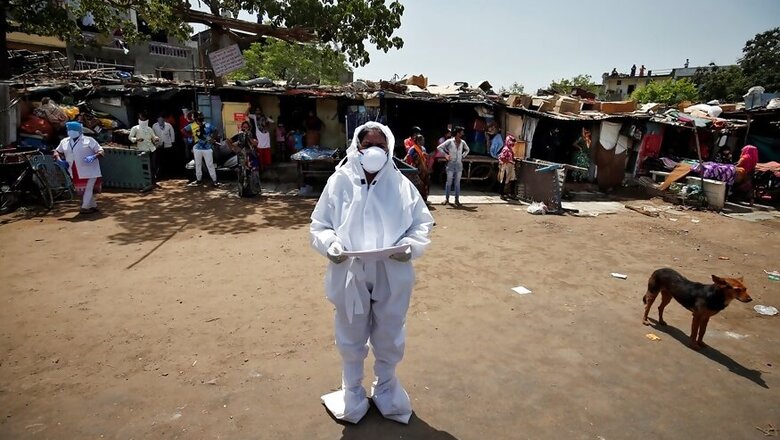
views
India saw a sharp rise in the number of cases and deaths between the 2nd and 5th of May. As many as 12,235 cases and 452 deaths were reported in this period, which basically implies an average of 3,059 cases and 113 deaths daily in these four days.
The 24-hour period from the 4th to the 5th saw the highest single-day numbers, both in terms of cases (3,875) and deaths (194). The average growth in the number of cases between the 26th to the 30th of April was 24.08%. This went up to 34.07% between the 1st and the 5th of May. What is a little more concerning is the rate of growth of deaths which went up from 28.14% to 38.14%. Nearly 27% of the total number of deaths in India happened in the four days.
There were two significant surges in the number of cases last week. A 9% increase from the 1st to the 2nd of May—just two days before the lockdown ended. And again a 9% increase from the 4th to the 5th of May—in the first 24 hours after lockdown 2 ended.
There has been an alarming rise in the number of cases and deaths from a few states in the last few days. Mumbai reported 635 new cases on Tuesday, taking the total tally of the city to 9,758. A total of 34 of the 36 districts in Maharashtra have been affected by the virus and the state has the maximum number of cases (16,758) in the country. Tamil Nadu reported 771 cases on Wednesday – the highest single-day rise in the state.
Gujarat reported 441 cases on Tuesday while Delhi had reported its highest surge on Wednesday (428). Punjab has also seen a sharp rise in the number of cases in the last few days, but around two-thirds of the total cases can be attributed to the Nanded gurdwara cluster. There has also been a sudden increase in the number of deaths from West Bengal with as many as 72 being reported on Monday.
Dr Ben Cowling, an epidemiologist at the University of Hong Kong, had stated that Asian countries could risk new waves of Covid-19 infections when they lift the lockdown. There are two ways in which this can happen. Asymptomatic carriers could spread the infection to a number of people seeing an exponential rise as social distancing norms are lifted or relaxed after a stringent lockdown. Second, international and domestic travellers could lead to the spread of the virus in the country.
India eased its stringent lockdown, giving a lot of concessions in the third phase which is scheduled to end on May 17, in a bid to get the economic engine of the country going. From opening liquor shops which saw scores of people openly violate social distancing norms to allowing 33% workforce in private offices, from transporting thousands of migrant workers to their villages to getting students and other Indians stranded abroad back to India, from opening most of the activities in Green and Orange Zones to even allowing some in the non-containment areas of the Red Zones/hotspots – there has been a shift in policy with the Centre allowing the respective states to take a final call on the severity of the lockdown.
Has this led to the sudden increase in the number of cases and deaths?
Unlikely, as there is a lag of at least a week before the impact of easing restrictions becomes apparent. Thus, India can expect to see a surge in the number of cases around May 10 as a direct consequence of easing curbs and norms after lockdown 2.
So then what has caused this sudden rise in the last four-five days?
The union home ministry blamed some states for releasing old data on Monday and the untimely reporting as the main reason for the surge in cases. "Some states had not been reporting Covid-19 cases timely. Timely reporting and management of cases is very crucial, but we found gaps in the data reported by some states. After due persuasion, the states filled in the gaps. This is the reason for the sudden spurt in the number of cases.”
Some other experts believe that the increase in the number of tests has in turn led to the rise in the number of cases and deaths.
Dr K Srinath Reddy, president of the Public Health Foundation of India, said, “As testing numbers increase, the number of cases we identify will also increase. We need to see if the number of new cases rise, as a proportion of new tests performed.”
India had a tests/case ratio of 23.72 on April 7. This rose to 23.82 on the 14th, 24.75 on the 21st, 25.31 on the 28th and 26.52 on the 5th of May. However, if we analyse the numbers in the last few days, there was a gradual decline from the 3rd of May (27.15) to the 5th of May (26.52).
The tests/death ratio rose from 711 (April 14) to 772 (April 21) to 788 (April 28) but fell to 780 on May 5. The decline was more severe between May 3 and May 5, when it went down from 821 to 780.
The mortality Rate went down from 3.35 mid-April (the 14th) to around 3.2 by close to the end of April (the 28th) but had risen to 3.4 by May 5.
So while one can conclude that the number of cases has risen mainly due to an increase in testing, the proportion of the rise in number of cases in the previous 3-4 days was marginally higher. However, it's not very significant yet and no major conclusions can be drawn as the time period is too small.
There was a sharper drop in the tests/death ratio and a sudden jump in the mortality rate over the past few days which may be a cause of slight worry but again the numbers are not alarming.
However, Dr Randeep Guleria, the director of AIIMS in Delhi, expressed caution over the recent trend. “The curve has remained relatively flat so far because of the implementation of the lockdown and other containment measures and this has given us time to prepare our health infrastructure and ramp up testing facilities in the country. However, the number of cases continues to rise steadily and this is a cause for concern,” he told PTI. But he added that although the curve is yet to show a downward trend the rise in the number of cases is not so sharp.
Some experts suggest that Covid-19 in India has not peaked yet and that could be one of the factors for the sudden rise in the number of cases and deaths.
Professor Bhramar Mukherjee, chair of biostatistics at the University of Michigan, expects the peak to hit India by the second half of May which suggests that we will continue to see a surge in cases till then. However, Professor T Jacob John, one of India’s leading experts and a retired professor of virology at the Christian Medical College, Vellore, believes that the lockdown may have pushed the peak to June-July.
The sudden rise in the number of cases and deaths from May 1 seems to be a combination of a lot of factors—delayed reporting by some states, more testing, violation of social distancing and India gradually moving towards its peak in the coming weeks.
The country should be prepared to see a big surge next week when the real impact of relaxing the lockdown will come into play.
Although India has done remarkably well in its Covid-19 fight so far, its toughest test might well be in the next few weeks.




















Comments
0 comment